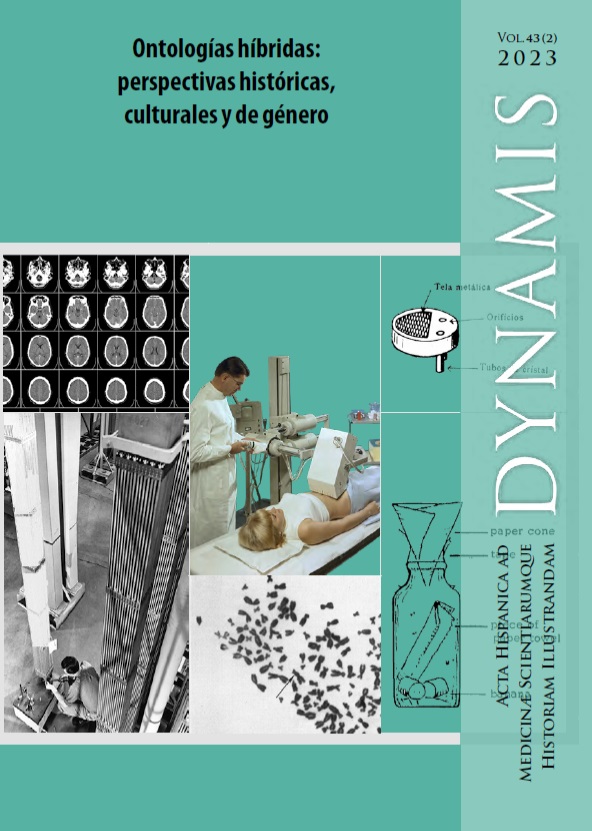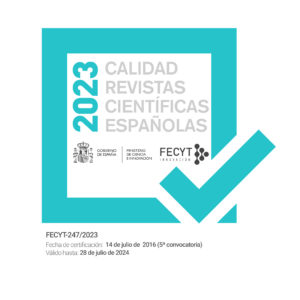Glass jars, bananas, and flies: gender, emotions, and practices of Drosophila genetics
DOI:
https://doi.org/10.30827/dynamis.v43i2.29444Keywords:
emotions, body, oral history, women history, Drosophila geneticsAbstract
Bananas and glass jars were and are components of the material culture of Drosophila genetics. These hybrid (material, sensory and emotional) objects circulated between the field and the laboratory and among the classrooms, research stations, and kitchens of those who dedicated themselves to studies of heredity and evolution. They also circulated through time and geographic space as they became part of the collective knowledge of the community of Drosophila geneticists and the memories of their daughters and sons. The combination of written, objective, conceptual and, above all, oral, subjective and emotional sources brings them to life along with the activities and practices of those who used them, almost always women; they have not been erased from these emotional records as they have been from institutional records. Norms also appear, such as gender norms, which surrounded people at the time of the experience and influenced their value judgments about the objects, practices and identities of those who carried them out. Thus, by studying the practices and objectsof a discipline such as Drosophila genetics, this article aims to contribute to the construction of a more inclusive history of genetics, to the history of women scientists and to studies on the role of emotions, the body, and memory in the construction of historical knowledge.
Downloads
References
Abir-Am, Pnina y Dorinda Outram (eds.). Uneasy Careers and Intimate Lives. Women in Science 1789-1979 (New Brunswick, London: Rutgers University Press, 1987).
Ahmed, Sara. La política cultural de las emociones. México: UNAM, 2015.
Allen, Garland E. “The introduction of Drosophila into the study of heredity and evolution: 1900-1910”, Isis 66, no. 233 (1975): 322-33. DOI: https://doi.org/10.1086/351472
Arbaiza, Mercedes. ““Sentir el cuerpo”: subjetividad y política en la sociedad de masas en España (1890-1936)”. Política y Sociedad 55, no. 1 (2018): 71-92. DOI: https://doi.org/10.5209/POSO.56798
Beers, Catherine V. “Linkage groups in Drosophila pseudoobscura, race B”. Genetics 22, no. 6 (1937): 577-586. DOI: https://doi.org/10.1093/genetics/22.6.577
Bridges, Calvin B. “Apparatus and Methods for Drosophila Culture”. The American Naturalist 66, no. 704 (1932): 250-273. DOI: https://doi.org/10.1086/280430
Bridges, Calvin B. y Milislav Demerec. Drosophila Information Service 5. Cold Spring Harbor: Carnegie Institution of Washinton, 1936.
Bridges, Calvin B. y Milislav Demerec. Drosophila Information Service 6. Methods issue. Cold Spring Harbor: Carnegie Institution of Washinton, 1936.
Bridges, Calvin B. y Milislav Demerec. Drosophila Information Service 7. Cold Spring Harbor: Carnegie Institution of Washinton, 1937.
Brush, Stephen G. “Nettie M. Stevens and the discovery of sex determination by chromoomes”. Isis 69, no. 2 (1978): 163-172. DOI: https://doi.org/10.1086/352001
Castle, William E., Frederic W. Carpenter, A. H. Clark, Samuel O. Mast y William M. Barrows. “The effects of inbreeding, cross-breeding, and selection upon the fertility and variability of Drosophila”, Proceedings of the American Academy of Arts and Sciences 41, no. 33 (1906): 731-786. DOI: https://doi.org/10.2307/20022155
Coe, Sophie Dobzhansky. “Theodosius Dobzhansky: A Family Story”. En The Evolution of Theodosius Dobzhansky: Essays on His Life and Thought in Russia and America, ed. Mark B. Adams, 13-28. Princeton, Nueva Jersey: Princeton University Press, 1994. DOI: https://doi.org/10.1515/9781400863808.13
Damasio, Antonio. La sensación de lo que ocurre. Cuerpo y emoción en la construcción de la conciencia. Madrid: Debate, 2001.
Delgado Echeverría, Isabel. El descubrimiento de los cromosomas sexuales: un hito en la historia de la biología. Madrid: Consejo Superior de Investigaciones Científicas, 2007.
Demerec, Milislav y Berwind P. Kaufman. Drosophila Guide: Introduction to the Genetics and Cytology of Drosophila melanogaster. Washington: Carnegie Institution of Washington, 1967.
Dietrich, Michael R. y Brandi H. Tambasco. “Beyond the Boss and the Boys: Women and the Division of Labor in Drosophila genetics in the United States, 1934-1970”, Journal of the History of Biology 40, no. (2012), 509-528. DOI: https://doi.org/10.1007/s10739-007-9131-y
Dobzhansky, Theodosius. “The Y chromosome of Drosophila pseudoobscura”. Genetics 20, no. 4 (1935a): 366-388. DOI: https://doi.org/10.1093/genetics/20.4.366
Dobzhansky, Theodosius. “Collecting, transporting, and shipping wild species of Drosophila”. Drosophila Information Service (DIS), 6 (1936): 28.
Dobzhansky, Theodosius y Sewall Wright. “Genetics of Natural Populations. XV. Rate of diffusion of a mutant gene through a population of Drosophila pseudoobscura”. Genetics 32 (1947): 303-324. DOI: https://doi.org/10.1093/genetics/32.3.303
Dobzhansky, Theodosius y Antonio Brito da Cunha. “Differentiation of Nutritional Preferences in Brazilian Species of Drosophila”. Ecology 36, no. 1 (1955): 34-39 DOI: https://doi.org/10.2307/1931428
Endersby, Jim. Una historia de la biología según el conejillo de indias. Las plantas y los animales que nos han enseñado a entender la vida. Madrid: Ariel, 2009.
Foucault, Michel. Vigilar y castigar. Madrid: Siglo XXI, 2005.
Fraser, Ronald. “Evocaciones de un pionero”. Historia, Antropología y Fuentes Orales 2, no. 40(2008): 75-78.
García Álvarez, Alejandro. “Santo, seña y ruta histórica del plátano hasta Cuba”. Revista de Indias LXI, no. 221 (2001): 141-166.
Gordon, Cecil. “A method for the direct study of natural selection”. Journal of Experimental Biology 16, no. 3 (1939): 278-285. DOI: https://doi.org/10.1242/jeb.16.3.278
Gordon, Cecil, Helen Spurway y P.A.R Street. “An analysis of three wild populations of Drosophila subobscura”. Journal of Genetics 38, no. 1-2 (1939): 37-90. DOI: https://doi.org/10.1007/BF02982165
Haraway, Donna. “Situated knowledges: The science question in feminism and the privilege of partial perspective”. Feminist studies 14, no. 3 (1988); 575-599. DOI: https://doi.org/10.2307/3178066
Harding, Sandra. ¿Existe un método feminista?: Feminismo y Metodología. Indianapolis: Indiana University Press, 1987 (Traducción de Gloria Bernal).
Harding, Sandra. Whose science? Whose knowledge?: Thinking from women’s lives. Ithaca: Cornell University Press, 1991.
Kelty, Christopher M. “This is not an article: Model organism newsletters and the question of ‘open science’”. BioSocieties 7, no. 2 (2012): 140-168. DOI: https://doi.org/10.1057/biosoc.2012.8
Kohler, Robert E. Lords of the fly: Drosophila genetics and the experimental life. Chicago y Londres: University of Chicago Press, 1994.
Lara, Alí y Giazú Enciso Domínguez. “El Giro Afectivo”, Athenea Digital. Revista de Pensamiento e Investigación Social 13, no. 3 (2013): 101-119. DOI: https://doi.org/10.5565/rev/athenead/v13n3.1060
Llona, Miren. Entreverse. Teoría y metodología práctica de las fuentes orales. Bilbao: Servicio Editorial de la Universidad del País Vasco, 2012.
Llona, Miren. “Historia en obras: memorias, emociones y subjetividad”. En Subjetividad, cultura material y género. Diálogos con la historiograf ía italiana, coordinado por Pilar Pérez-Fuentes Hernández, 153-169. Barcelona: Icaria, 2015.
Maienschein, Jane. One Hundred Years Exploring Life, 1888-1988: The Marine Biological Laboratory at Woods Hole. Boston: Jones and Bartlett Publishers, 1989. DOI: https://doi.org/10.5962/bhl.title.14377
Massumi, Brian. “The Autonomy of Affect”. Cultural Critique 31 (1995): 83-109.
http://dx.doi.org/10.2307/1354446. DOI: https://doi.org/10.2307/1354446
Metz, Charles. “Chromosomes studies in Diptera I. A preliminary survey of five different types of chromosomes groups in the genus Drosophila”. Journal of experimental Zoology 17, no. 1 (1914): 45-59. DOI: https://doi.org/10.1002/jez.1400170103
Monclús, María. “Distribución y ecología de drosof ílidos en España. I. Especies de Drosophila de la región catalana”. Genética Ibérica 16, no. 3-4 (1964): 143-165.
Morgan, Thomas H. y Sabra Colby Tice. “The influence of the environment on the size of expected classes”. Biological Bulletin 26, no. 4 (1914): 213-220. DOI: https://doi.org/10.2307/1536195
Nuez Yánez, Juan S. “El plátano canario en el mercado europeo, 1870-1996”. Comunicación presentada en el VI Congreso Nacional de la Asociación de Historia Económica (Girona, 15-17 de septiembre de 1997), pp. 129-136. Disponible en: https://www.aehe.es/wp-content/uploads/1989/10/NUEZ1.pdf
Ogilvie, Marilyn Bailey y Choquette, Clifford J. “Nettie Maria Stevens (1861-1912): her life and con-tributions to cytogenetics”. Proceedings of the American Philosophical Society 125, no. 4 (1981): 292-311.
Ortiz-Gómez, Teresa. “Fuentes orales e identidades profesionales: las médicas españolas en la segunda mitad del siglo XX”. Asclepio. Revista de Historia de la Medicina y de la Ciencia 57, no. 1 (2005): 75-98. DOI: https://doi.org/10.3989/asclepio.2005.v57.i1.31
Pycior, Helena M., Nancy G. Slack y Pnina G. Abir-Am (eds.). Creative Couples in the Sciences. New Brunswick: Rutgers University Press,1996.
Reed, Elizabeth Wagner. “Plants for Classroom Use”. Journal of the Minnesota Academy of Science, 36 no. 1(1969): 62-63.
Reed, Sheldon C. y Elizabeth W. Reed. “Morphological differences and problems of speciation in Drosophila”. Evolution 2, no. 1 (1948a): 40-48. DOI: https://doi.org/10.1111/j.1558-5646.1948.tb02730.x
Reed, Sheldon C. y Elizabeth W. Reed. “Natural Selection in Laboratory Populations of Drosophila”. Evolution 2, no. 2 (1948b): 176-186. DOI: https://doi.org/10.1111/j.1558-5646.1948.tb02739.x
Reed, Sheldon C. y Elizabeth W. Reed. “Natural selection in laboratory populations of Drosophila. II. Competition between a white eye gene and its wild type allele”. Evolution 4, no. 1 (1950): 34-42. DOI: https://doi.org/10.1111/j.1558-5646.1950.tb01381.x
Richmond, Marsha L. “Women in the early history of genetics: William Bateson and the Newnham College Mendelians, 1900-1910”. Isis 92, no. 1 (2001): 55-90. DOI: https://doi.org/10.1086/385040
Romero de Pablos, Ana. “Pioneras pero invisibles: las calculistas del Laboratorio y Taller de Investigación del Estado Mayor de la Armada”. Clepsidra, 15 (2016): 49-62.
Rosón, María y Rosa Medina Domenech. “Resistencias emocionales. Espacios y presencias de lo íntimo en el archivo histórico”. Arenal: Revista de Historia de las Mujeres 24, no. 2 (2017): 407-439.
Rossiter, Margaret W. Women Scientists in America. Vol. 1: Struggles and Strategies to 1940. Baltimore, Maryland: Johns Hopkins University Press, 1982 DOI: https://doi.org/10.56021/9780801824432
Rossiter, Margaret. “Which Science? Which Women?”. Osiris 12 (1997): 169-185. DOI: https://doi.org/10.1086/649272
Santesmases, María Jesús. “Women in Early Human Cytogenetics: An Essay on a Gendered History of Chromosome Imaging”. Perspectives on Science 28, no. 2 (2020): 170-200. https://doi.org/10.1162/posc_a_00337. DOI: https://doi.org/10.1162/posc_a_00337
Santesmases, María Jesús. “Standard Making in Cytogenetics: the Manufacture, Circulation and Reproduction of Chromosome Images”, HoST- Journal of History of Science and Technology 14, no. 1 (2020): 52-78. DOI: https://doi.org/10.2478/host-2020-0004
Santesmases, María Jesús. “Imaging the Super-Female: Women, Gender and Handbooks in the History of a Genetic Term”. Medicina nei Secoli 29, no. 1 (2017): 1131-1152.
Santesmases, María Jesús. “Circulating biomedical images: Bodies and chromosomes in the post-eugenic era”. History of Science 55, no. 4 (2017): 395-430. doi:10.1177/0073275317701145. DOI: https://doi.org/10.1177/0073275317701145
Saphin, Steven. “The invisible technician”. American Scientist 77 (1989): 554-563.
Satzinger, Helga. “The Politics of Gender Concepts in Genetics and Hormone Research in Germany, 1900-1940”. Gender & History 24, no. 3 (2012): 735-754. DOI: https://doi.org/10.1111/j.1468-0424.2012.01703.x
Satzinger, Helga. “Women’s Places in the New Laboratories of Biological Research in the 20th century: Gender, Work and the Dynamics of Science”, en Women Scholars and Institutions. Proceedings of the International Conference (Prague, June 8-11, 2003), eds. Soňa Štrbáňová, Ida H. Stamhuis y Kateřina Mojsejová (Praga, 2004), 265-294. https://doi.org/10.25595/246.
Stevens, Nettie Marie. “A Study of the Germ Cells of Certain Diptera, with reference to the heterochromosomes and the phenomena of synapsis”. Journal of Experimental Biology 5, no. 3 (1908): 359-374. DOI: https://doi.org/10.1002/jez.1400050304
Subarsky, Zachariah, Elizabeth W. Reed, Edward R. Landin y Barrie G. Klaits. Living things in field and classroom: A Minnemast handbook for teachers of early elementary grades. Minnesota: Minnesota Mathematics and Science Teaching Project, 1967.
Sturtevant, Alfred H. The North American species of Drosophila. Washington: Carnegie Institute of Washington, 1921. DOI: https://doi.org/10.5962/bhl.title.10480
Velasco-Martín, Marta. “Genetistas de moscas y estudiosas de virus: tecnólogas, científicas, naturalistas”, en Tecnología, ciencia y naturaleza en la historia de las mujeres, eds. Miren Llona y María Cruz de Carlos, 185-201. Madrid: Comares, 2023.
Velasco-Martín, Marta. “Women and Partnership Genealogies in Drosophila Population Genetics”. Perspectives on Science 28, no. 2 (2020): 277-317. DOI: https://doi.org/10.1162/posc_a_00341
Velasco-Martín, Marta. “Genética de Drosophila y género: circulación de objetos y saberes”. Tesis doctoral, Universidad de Salamanca, 2019.
Velasco-Martín, Marta. “Moscas y redes: María Monclús y la genética de poblaciones en España”. Arenal 24, no. 2 (2017): 349-378
Downloads
Published
How to Cite
Issue
Section
License
Copyright (c) 2023 Dynamis

This work is licensed under a Creative Commons Attribution-NonCommercial-NoDerivatives 4.0 International License.
Dynamis se encuentra adherida a una licencia Creative Commons Reconocimiento (by), la cual permite cualquier explotación de la obra, incluyendo una finalidad comercial, así como la creación de obras derivadas, la distribución de las cuales también está permitida sin ninguna restricción.

















